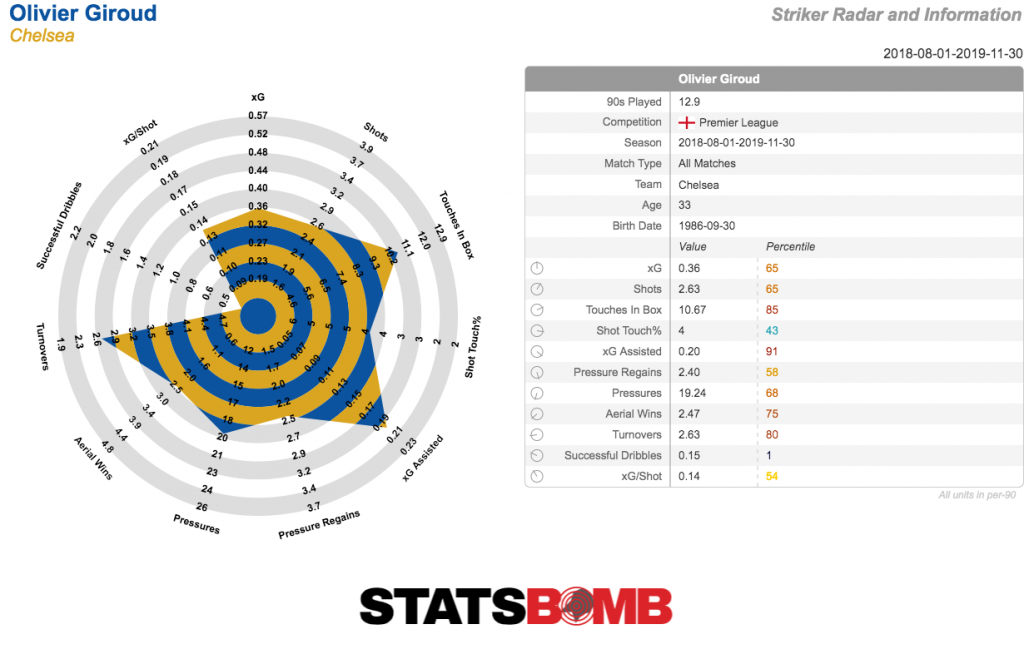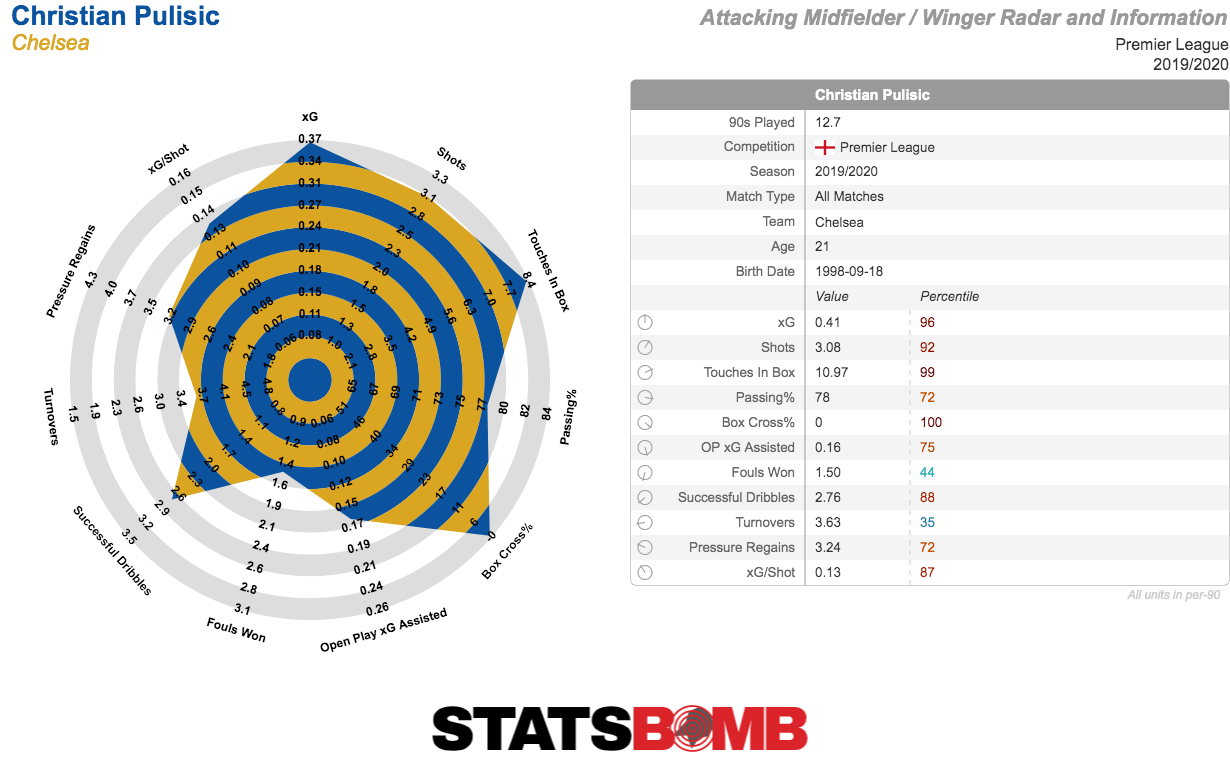It started so well. All signs pointed to Frank Lampard’s Chelsea reboot being a big success. It wasn’t perfect, but Chelsea won eight of their first twelve Premier League games in a manner that suggested they were the real deal. Beyond the results, the metrics looked even better. Lampard’s side had a better than expected goal difference than Liverpool after twelve matches. 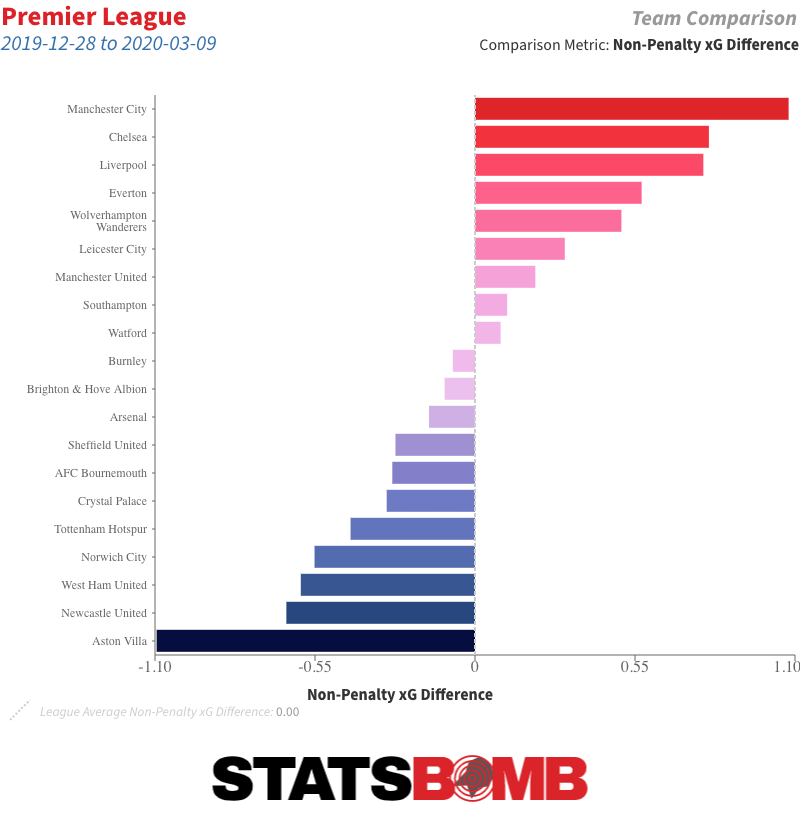 After selling the club’s signature player in Eden Hazard, buying no one due to a transfer ban, and putting an inexperienced beloved former player in charge, this was quite the surprise. The core of it seemed to stem from the excellent form of academy graduates, most prominently Tammy Abraham and Mason Mount, who were finally given opportunities in the first team. Lampard’s football is far less restrictive than Maurizio Sarri’s very precise possession-based system, thus allowing a player like Mateo Kovačić to perform in a manner closer to his natural game than be stuck in the uncomfortable role he occupied previously. Even Jorginho, the avatar of Sarriball, looked like he enjoyed the greater freedom afforded under the new man in charge. And then the results just stopped coming. Four wins versus six losses in the last twelve games. The fact that Manchester United and Tottenham have been underperforming is all that’s keeping Chelsea in a good position to finish in the top four. But how did this happen? Why did it suddenly go wrong? Purely in terms of expected goals, not much has changed. Chelsea had an xG difference per game of +0.83 in the first twelve fixtures and +0.72 in the second 12. On the defensive end, things look absolutely fine. Chelsea conceded 0.92 xG per game and now they concede 0.86. As seen on the radar below, they’re bringing their defensive work higher up the pitch than before, allowing the opposition fewer passes before attempting to win the ball, and further restricting opponents’ ability to keep possession. Chelsea look like they’re becoming a more complete pressing unit.
After selling the club’s signature player in Eden Hazard, buying no one due to a transfer ban, and putting an inexperienced beloved former player in charge, this was quite the surprise. The core of it seemed to stem from the excellent form of academy graduates, most prominently Tammy Abraham and Mason Mount, who were finally given opportunities in the first team. Lampard’s football is far less restrictive than Maurizio Sarri’s very precise possession-based system, thus allowing a player like Mateo Kovačić to perform in a manner closer to his natural game than be stuck in the uncomfortable role he occupied previously. Even Jorginho, the avatar of Sarriball, looked like he enjoyed the greater freedom afforded under the new man in charge. And then the results just stopped coming. Four wins versus six losses in the last twelve games. The fact that Manchester United and Tottenham have been underperforming is all that’s keeping Chelsea in a good position to finish in the top four. But how did this happen? Why did it suddenly go wrong? Purely in terms of expected goals, not much has changed. Chelsea had an xG difference per game of +0.83 in the first twelve fixtures and +0.72 in the second 12. On the defensive end, things look absolutely fine. Chelsea conceded 0.92 xG per game and now they concede 0.86. As seen on the radar below, they’re bringing their defensive work higher up the pitch than before, allowing the opposition fewer passes before attempting to win the ball, and further restricting opponents’ ability to keep possession. Chelsea look like they’re becoming a more complete pressing unit. 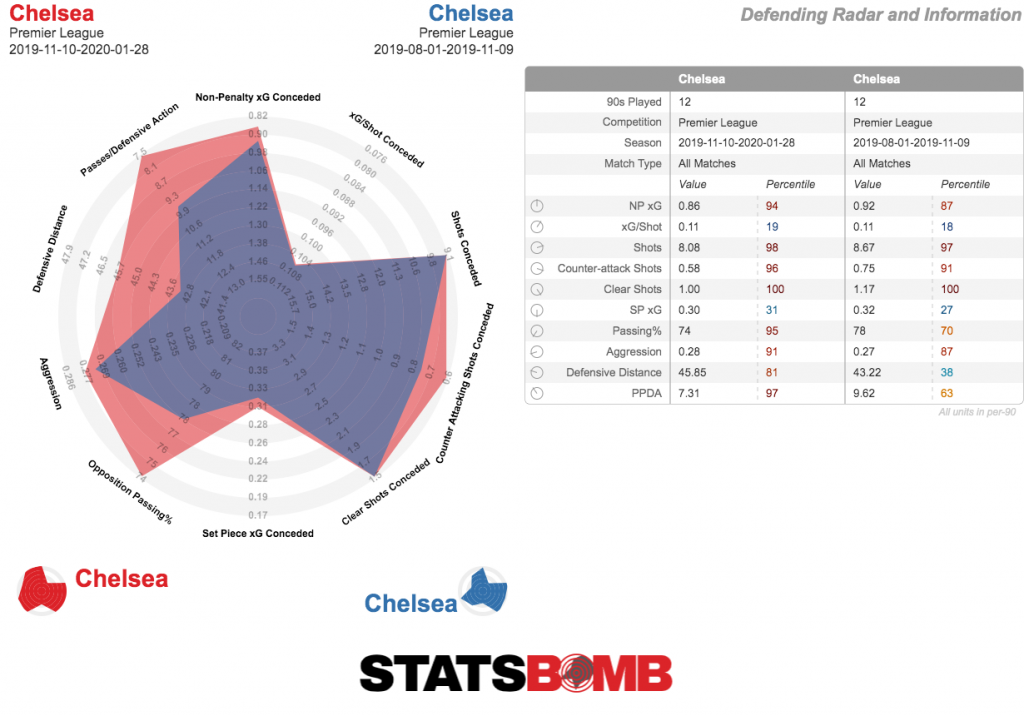 The Blues have been consistent in conceding moderately more goals than expected this season. It’s possible that much of this is the fault of Kepa Arrizabalaga, who has never looked impressive in the shot-stopping numbers. But even so, he doesn't account for the entire problem. Chelsea have conceded 21.54 xG on the conventional model, 24.17 xG on the post-shot model, and 28 non-penalty goals in reality. If Kepa is at fault, he cannot solely be to blame for opposing attackers hitting their shots particularly well; at least, according to the data.. Another possibility, albeit difficult to find evidence for in the data, is that Chelsea’s particularly open style leads to conceding shots that are better than the model thinks. But these are fairly out-there hypotheticals. The most likely scenario is that this is just a case of shit happens, and we shouldn’t expect the side to continue to let in goals like this if nothing else changes. It’s the attacking side, though, where the data looks a little more tangible. Eleven non-penalty goals from the last twelve games against twenty-six from the first twelve massively exaggerates the issue, but there has been a real decline.
The Blues have been consistent in conceding moderately more goals than expected this season. It’s possible that much of this is the fault of Kepa Arrizabalaga, who has never looked impressive in the shot-stopping numbers. But even so, he doesn't account for the entire problem. Chelsea have conceded 21.54 xG on the conventional model, 24.17 xG on the post-shot model, and 28 non-penalty goals in reality. If Kepa is at fault, he cannot solely be to blame for opposing attackers hitting their shots particularly well; at least, according to the data.. Another possibility, albeit difficult to find evidence for in the data, is that Chelsea’s particularly open style leads to conceding shots that are better than the model thinks. But these are fairly out-there hypotheticals. The most likely scenario is that this is just a case of shit happens, and we shouldn’t expect the side to continue to let in goals like this if nothing else changes. It’s the attacking side, though, where the data looks a little more tangible. Eleven non-penalty goals from the last twelve games against twenty-six from the first twelve massively exaggerates the issue, but there has been a real decline. 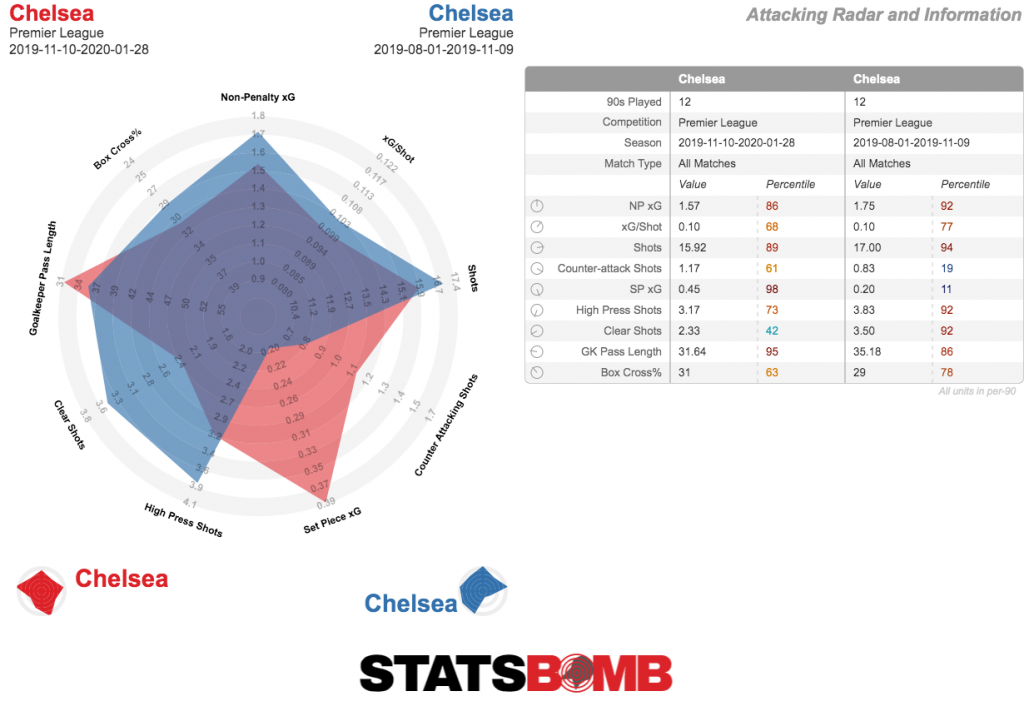 What’s obvious visually is that the one big positive recently are the set pieces. They’re running a touch cold here, scoring 4 goals from 5.57 xG, but set pieces can be utilised effectively in any club’s attack and it’s good to see Chelsea making progress . . . although, it could just be a couple of really good shots skewing the numbers in the sample. Either way, it’s covering for an even bigger problem in open play. Here, Chelsea have gone from generating 1.76 xG per game to just 1.13. Their finishing has been horrendous recently, but even so, this just isn’t what their fans want to see.
What’s obvious visually is that the one big positive recently are the set pieces. They’re running a touch cold here, scoring 4 goals from 5.57 xG, but set pieces can be utilised effectively in any club’s attack and it’s good to see Chelsea making progress . . . although, it could just be a couple of really good shots skewing the numbers in the sample. Either way, it’s covering for an even bigger problem in open play. Here, Chelsea have gone from generating 1.76 xG per game to just 1.13. Their finishing has been horrendous recently, but even so, this just isn’t what their fans want to see. 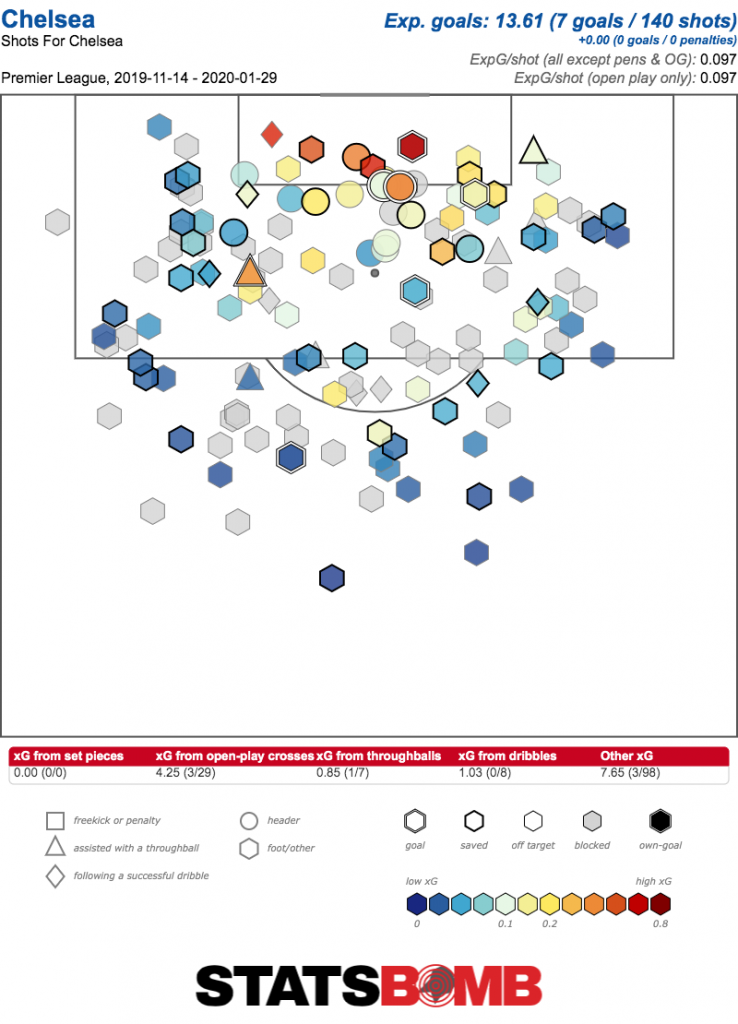 We can see this with Abraham. He hasn’t been bad, exactly, but his numbers have definitely taken a hit. He ran a little over xG in the fall and a little under it since, which once again exaggerates things, but it’s clear that he hasn’t been getting good chances quite as often.
We can see this with Abraham. He hasn’t been bad, exactly, but his numbers have definitely taken a hit. He ran a little over xG in the fall and a little under it since, which once again exaggerates things, but it’s clear that he hasn’t been getting good chances quite as often. 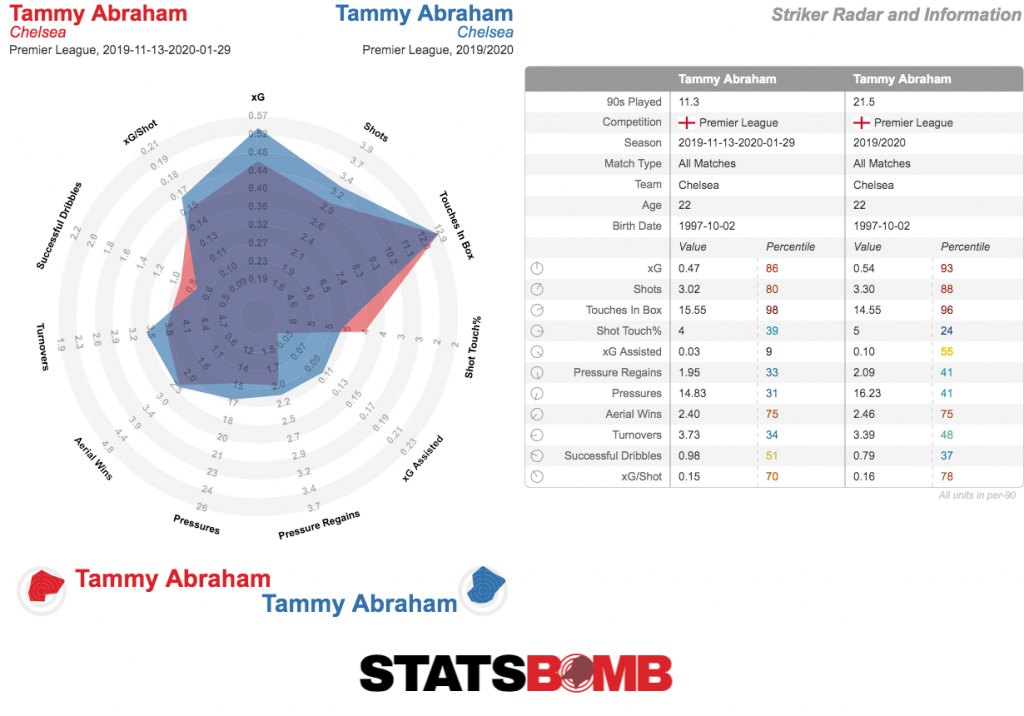 Overall, though, Chelsea appear the same as they were earlier in the year. The shift in results is down to chances not going in more than any other aspect of their performance. So what do we know about Chelsea overall at this stage? Well, the youth revolution has been a clear success. Fikayo Tomori has played more than half the available league minutes and looked absolutely capable as a Champions League side’s centre back at age 22. Though he was obviously bought for an obscene amount of money, Christian Pulisic should be included in this bracket, and he leads the Premier League in xG and xG assisted per 90 for players 21 or younger. It’s hard to ask a 21-year-old arriving in a new country to do much more than he has so far.
Overall, though, Chelsea appear the same as they were earlier in the year. The shift in results is down to chances not going in more than any other aspect of their performance. So what do we know about Chelsea overall at this stage? Well, the youth revolution has been a clear success. Fikayo Tomori has played more than half the available league minutes and looked absolutely capable as a Champions League side’s centre back at age 22. Though he was obviously bought for an obscene amount of money, Christian Pulisic should be included in this bracket, and he leads the Premier League in xG and xG assisted per 90 for players 21 or younger. It’s hard to ask a 21-year-old arriving in a new country to do much more than he has so far.  But what if I told you the second-best young player in this metric is also at Chelsea? And what if I told you he’s more than two years younger than Pulisic? You’d be pretty interested in that player, right?
But what if I told you the second-best young player in this metric is also at Chelsea? And what if I told you he’s more than two years younger than Pulisic? You’d be pretty interested in that player, right? 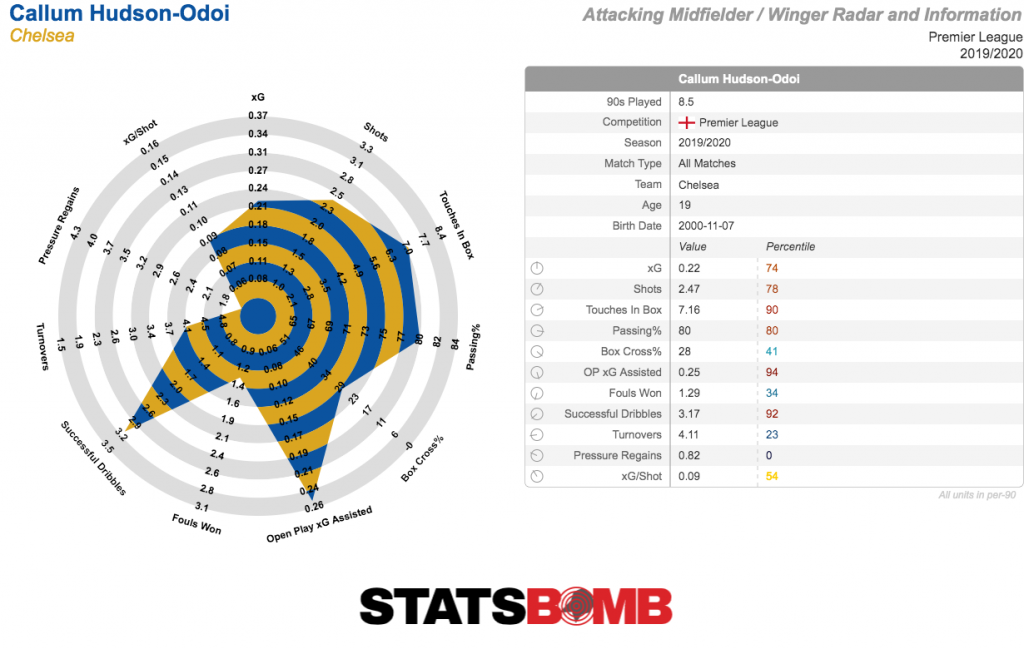 Seeing as Chelsea are supposedly interested in spending a lot of money on Jadon Sancho, and given the Borussia Dortmund man is a terrific talent who could bring a lot to any side, they already have an exciting long-term front three with Pulisic and Callum Hudson-Odoi either side of Abraham. Mason Mount, another attacking player, has received a lot of hype this season, and it’s not unwarranted. English football is good at producing young players who press well and get shots, which is a mould Mount fits right into. But he does need to develop his game beyond that. All Chelsea outfield players to have featured for at least 600 minutes (bar Abraham) average more passes per 90, and even players like César Azpilicueta and N'Golo Kanté complete more passes in the final third than Mount. The comparisons to his manager are clear and not unfair, but while he’s got the basics down, he should remember that Lampard also developed an excellent passing game over time.
Seeing as Chelsea are supposedly interested in spending a lot of money on Jadon Sancho, and given the Borussia Dortmund man is a terrific talent who could bring a lot to any side, they already have an exciting long-term front three with Pulisic and Callum Hudson-Odoi either side of Abraham. Mason Mount, another attacking player, has received a lot of hype this season, and it’s not unwarranted. English football is good at producing young players who press well and get shots, which is a mould Mount fits right into. But he does need to develop his game beyond that. All Chelsea outfield players to have featured for at least 600 minutes (bar Abraham) average more passes per 90, and even players like César Azpilicueta and N'Golo Kanté complete more passes in the final third than Mount. The comparisons to his manager are clear and not unfair, but while he’s got the basics down, he should remember that Lampard also developed an excellent passing game over time. 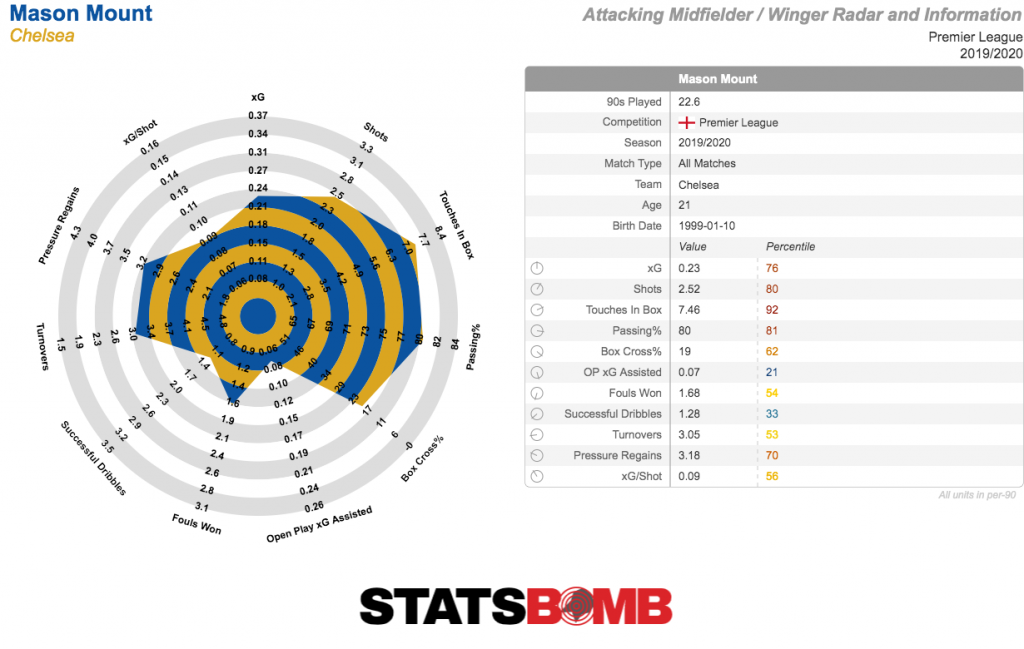 What Chelsea have is a somewhat messy, swashbuckling style of football played by a young group of players direced by a young manager. There's no doubt that this group of players will continue to mature, and with the set of individuals around there’s a very good chance of at least one going supernova. And the talent from the academy doesn’t seem to be drying up any time soon. Figuring out a pathway for these players to the senior side was crucial, and Chelsea should reap the rewards for many years to come. Lampard’s ability as a manager does remain something of an open question, though. What he’s done right at Chelsea so far is to listen to the players' thoughts on their own strengths and give them enough slack to do what they’re comfortable with. He’s also looked to install a high pressing game. In the long term, Chelsea will surely need to develop a clear plan in possession more structured than they have right now. There's really no way to know if Lampard is capable of doing that. But for now, the club are on the right track, and no fans should worry too much about recent results.
What Chelsea have is a somewhat messy, swashbuckling style of football played by a young group of players direced by a young manager. There's no doubt that this group of players will continue to mature, and with the set of individuals around there’s a very good chance of at least one going supernova. And the talent from the academy doesn’t seem to be drying up any time soon. Figuring out a pathway for these players to the senior side was crucial, and Chelsea should reap the rewards for many years to come. Lampard’s ability as a manager does remain something of an open question, though. What he’s done right at Chelsea so far is to listen to the players' thoughts on their own strengths and give them enough slack to do what they’re comfortable with. He’s also looked to install a high pressing game. In the long term, Chelsea will surely need to develop a clear plan in possession more structured than they have right now. There's really no way to know if Lampard is capable of doing that. But for now, the club are on the right track, and no fans should worry too much about recent results.
Stats of Interest
Ask any traditionalist what a newly promoted team needs to get right in order to stay in the Premier League, and chances are that “defending set pieces” will be a key point. Which should be a real cause of concern for Aston Villa. The Midlands side are the worst team in the Premier League when it comes to xG conceded from set plays. Realistically Villa are currently a toss up for relegation, but things would look a lot more secure if they could fix this. 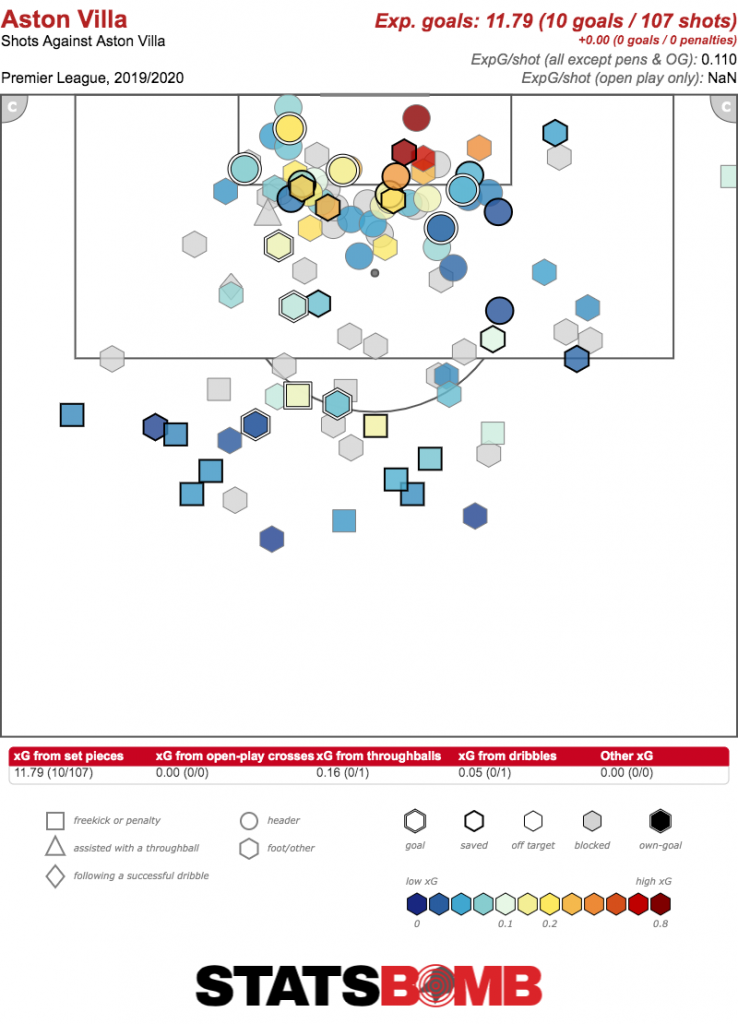 If you want an example of a promoted side who defend from set pieces properly, look no further than Sheffield United.
If you want an example of a promoted side who defend from set pieces properly, look no further than Sheffield United. 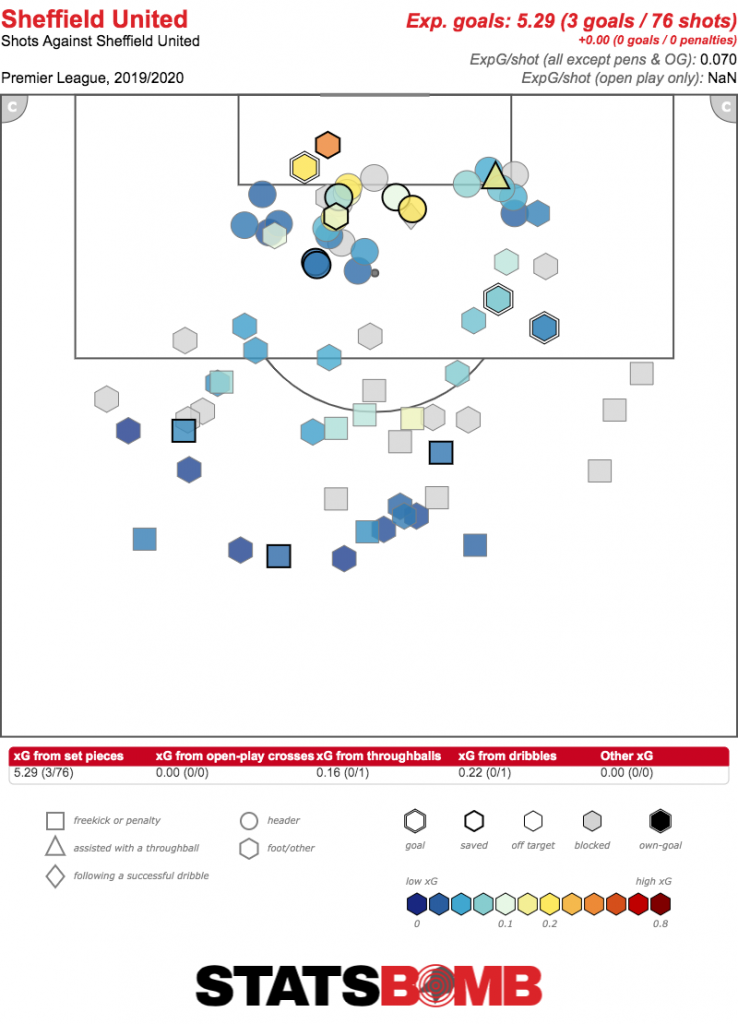 In a very quiet January transfer window, some talk has emerged of Olivier Giroud making the move to Tottenham. Of course, players can fall off a cliff in their 30s at any point, but if Spurs can get the same production out of him as he’s delivered over the last 18 months, he would be a decent short term solution. Just as long as they don’t tie him to a ludicrous contract.
In a very quiet January transfer window, some talk has emerged of Olivier Giroud making the move to Tottenham. Of course, players can fall off a cliff in their 30s at any point, but if Spurs can get the same production out of him as he’s delivered over the last 18 months, he would be a decent short term solution. Just as long as they don’t tie him to a ludicrous contract. 